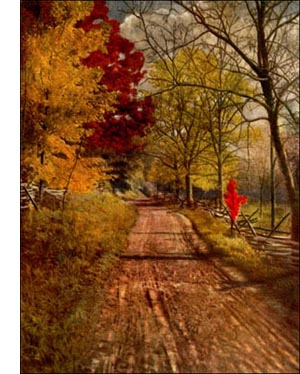Balsam Fir Tree
 Balsam Fir (Abies balsamea, Mill.)-A broad, pyramidal tree, 5o to 6o feet high, with slender pubescent branchlets. Bark brown, thin, broken into scaly plates with dried balsam in white blisters. Wood soft, weak, coarse, brown with yellow streaks, not durable. Leaves blunt, dark green, lustrous above, with pale linings, 1/2 to 1 1/2 inches long, spreading in 2-ranked order. Flowers axillary, staminate, yellow shaded to purplish; pistillate purple. Fruit erect, rich purple, oblong-cylindrical, 2 to 4 inches long, blunt at ends; scales broad, entire, closely overlapping. Preferred habitat, swamps or hilly slopes. Distribution, Labrador through Canada and New England, to Minnesota; south along mountains to southwestern Virginia. Uses: Wood used for box material; bark furnishes oil and Canada balsam, used in medicine and in the arts. Fresh leaves cut for balsam pillows.
Balsam Fir (Abies balsamea, Mill.)-A broad, pyramidal tree, 5o to 6o feet high, with slender pubescent branchlets. Bark brown, thin, broken into scaly plates with dried balsam in white blisters. Wood soft, weak, coarse, brown with yellow streaks, not durable. Leaves blunt, dark green, lustrous above, with pale linings, 1/2 to 1 1/2 inches long, spreading in 2-ranked order. Flowers axillary, staminate, yellow shaded to purplish; pistillate purple. Fruit erect, rich purple, oblong-cylindrical, 2 to 4 inches long, blunt at ends; scales broad, entire, closely overlapping. Preferred habitat, swamps or hilly slopes. Distribution, Labrador through Canada and New England, to Minnesota; south along mountains to southwestern Virginia. Uses: Wood used for box material; bark furnishes oil and Canada balsam, used in medicine and in the arts. Fresh leaves cut for balsam pillows.In the North Woods the hunter cuts the fragrant boughs of the fir balsam to make his bed, and the ladies of every camping party industriously shear balsam twigs in order to fill sofa pillows later with the leaves. The native finds it profitable to collect the limpid balsam by draining the white resin blisters that occur plentifully on the smooth bark of young trees, and on the limbs of older ones. Wounding the tree produces increased flow. Whole families are often employed in this enterprise. The resin thus obtained is the "Canada balsam" employed in every laboratory for the mounting of microscopic specimens. It is used also in the practise of medicine and in other useful arts. "Oil of fir" is also obtained from the bark.
The erect cones of this tree distinguish it from the spruces with which it grows, and the hemlocks whose leaves are also pale beneath and 2-ranked in arrangement. Balsam fir leaves are blunt and stemless. Hemlock leaves have minute petioles.
The cultivation of balsam fir has been rather stupidly continued in the Northeastern States, despite the fact that the tree is short lived and early loses its lower limbs. There are other firs that may be as easily obtained and grown, and these are chosen by wise planters for their greater beauty and longer life.